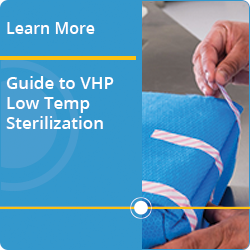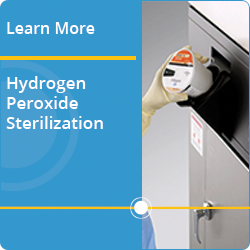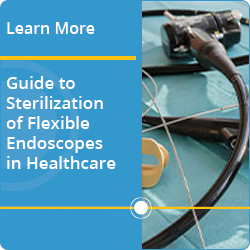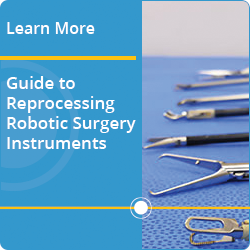Knowledge Center
October 2, 2024
Expanding Sterilization Options for Medical Devices
How to Sterilize Flexible Scopes, Laryngoscope Blades, Batteries, and more

Sterilization renders a medical device free from viable microorganisms to help prevent the transmission of harmful organisms to patients and help reduce the risk of hospital-acquired infections (HAI). According to the United States Food & Drug Association (FDA), sterilization methods, including steam sterilization and Ethylene Oxide, have a "long history of safe and effective use on medical devices" and are considered "Established Category A Sterilization Methods." With the recent FDA recognition of the ISO standard 22441:2022, the FDA is adding VH2O2 (vaporized hydrogen peroxide) low-temperature sterilization as an Established Category A sterilization method.1
While VH2O2 has been used for many years in sterile processing with systems including V-PRO™ Low Temperature Sterilizers, this new classification highlights the importance and versatility of VH2O2 sterilization. Some technicians may think hydrogen peroxide sterilizers are just for batteries and cameras and may not be aware that this technology can quickly sterilize many other devices with no cooldown period needed.
An Alternative Way to Sterilize Medical Devices
AORN States:
“Steam sterilization is the most-commonly-used method of reprocessing surgical instruments, but some devices can't stand up to the heat or pressure of the autoclave. Electronic components require delicate handling, plastic can be compromised, and lenses can fog. For these and other high-maintenance items, low-temperature sterilization bridges the gap to ensure infection prevention.3
Steam sterilization has long been an established method of sterilizing medical devices. However, not all devices are compatible with this modality. Devices that are heat-sensitive or not materially compatible with high temperatures cannot be sterilized using steam.
In addition to material compatibility, healthcare facilities can find cost savings by using a low temperature sterilizer compared to exposing certain common devices to higher temperatures. In the study, "An economic analysis of the benefits of sterilizing medical instruments in low-temperature systems instead of steam," it was shown that hydrogen peroxide-based (VH2O2) low-temperature sterilization does less damage to medical instruments than steam autoclaves, resulting in lower repair and replacement costs.2
Below is a list of some of the medical device types that can be sterilized using VH2O2*
- Flexible Cystoscopes, Bronchoscopes and Ureteroscopes
- Laryngoscope Blades
- Batteries for Medical Devices
- Rigid Endoscopes
- Transesophageal Echocardiogram (TEE) Probes
- Ultrasound Probes & Transducers
How to Sterilize Flexible Cystoscopes, Bronchoscopes and Ureteroscopes*

Flexible endoscopes are used for various diagnostic, therapeutic, and surveillance purposes. Procedures that utilize flexible endoscopes may be performed at hospitals, clinics, and outpatient or ambulatory surgery centers (ASCs). There are many types of flexible endoscopes. Read more about the sterilization of common scopes used in GI procedures in our article, "Guide to Sterilization of Flexible Endoscopes in Healthcare.” This section will focus on sterilization of Cystoscopes, Bronchoscopes, and Ureteroscopes.
- Cystoscopes: These are inserted through the urethra into the bladder so the endoscopist can view the inside of the bladder and urethra in detail. They are often used to find causes of bleeding, blockage, or abnormalities of the bladder and its lining.
- Bronchoscopes: These are inserted through the patient's nose or mouth and are used to examine the patient's trachea, bronchi, and lungs for abnormalities such as foreign bodies, bleeding, inflammation, and tumors.
- Ureteroscope: Inserted through the urethra and bladder and up the ureter to address kidney stones
In recent years, there have been multiple reports of patient infections and other possible contamination issues associated with reprocessed urological endoscopes and bronchoscopes. As a result, these devices have been under an increased level of scrutiny:
A 2021 safety communication recommends that healthcare facilities and staff "consider using sterilization instead of high-level disinfection (HLD) when feasible because sterilization has a greater safety margin than high-level disinfection." 4
Not all flexible endoscopes are compatible with high-temperature steam sterilization, so two compatible low-temperature sterilization options for sterilizing flexible endoscopes are: VH2O2 and Liquid Chemical Sterilization (LCS). V-PRO Sterilizers offer fast cycle options and ensure terminal sterilization using VH2O2 in as little as 16 minutes for validated and properly prepared non-lumened flexible endoscopes. With no cooldown period, devices can be used immediately after following policies and procedures for release.
Sample scopes that can be terminally sterilized using V-PRO Sterilizers* include:
- Karl Storz Flexible Bronchoscope 11001BI1
- Richard Wolf Flexible Cystoscope 7305.001
- Olympus Ureteroscope URF-P5
- Laborie BRS-4000 Flexible Fiber Bronchoscope
How to Sterilize Laryngoscope Blades*

Laryngoscopes are used to assist in the visualization of the trachea during intubation of patients and aid in the visualization of a patient's vocal cords and nearby structures during a laryngoscopy. A laryngoscopy may be performed to look for causes of symptoms in the throat or voice box, to get a biopsy of any abnormal areas, or to treat problems in the voice box, such as early cancers.
Airway device-associated infections caused by cross-contamination are one of the most critical and problematic types of healthcare-associated infections5. As a result, there is a high level of scrutiny around the processing and storage of laryngoscope blades.
Terminal sterilization is an effective way to minimize the risk of microbial contamination, but some laryngoscope blades are incompatible with steam sterilization. If compatible, a typical steam cycle time for 4-minute sterilization and 30-minute dry time is approximately 1 hour. Additionally, some instructions for use (IFU) require 45 minutes or longer dry time, and cooling time can require two hours or more.
V-PRO Sterilizers offer fast cycle options and ensure terminal sterilization in as little as 16 minutes for properly prepared medical devices. VH2O2 sterilization operates at a low temperature, so staff can use devices or instruments immediately following their policies and procedures for release.
Sample of Laryngoscopes that can be terminally sterilized using V-PRO Sterilizers* include:
- Heine F.O. Laryngoscope Blade MAC 0 F-000.22.100
- Karl Storz C-MAC D-BLADE 8403HX
- SunMed Adult Laryngoscope Blade 5-3073-02
- Teleflex Snaplight FO Miller Blade 00 002200000
How to Sterilize Batteries for Medical Devices*

Handheld power devices are tools driven by an external power source. They play specialized roles in the operating room (OR), where they are used for precision cutting, drilling, sculpting, and shaving. In hospitals, you'll encounter handheld power devices used for performing procedures such as orthopedics, neurology, spine, dental, ENT, plastics, and cardiothoracic.
Many of the powered orthopedic devices are cordless and use batteries, which are considered heat-sensitive medical devices. If a battery is inadvertently exposed to longer sterilization or drying time beyond what is stated in the battery manufacturer's IFU, the battery may be damaged.
VH2O2 sterilization is a low temperature sterilization process that typically operates around 50°C, or 122°F. This makes it compatible with delicate, heat-sensitive devices, like batteries, that can be compromised by exposure to high temperatures.
Sample Batteries that can be terminally sterilized using V-PRO Sterilizers* include:
- Stryker System 8 Large Battery 8215-000-000
- DePuy Synthes Power Line II Battery 530.630
- Stryker SmartLiFE Large Battery 7215-000-000
- ConMed Hall® Lithium Battery, Large L3000LG
How to Sterilize Rigid Endoscopes*

Unlike a flexible scope, the main body of a rigid endoscope cannot be bent or twisted. Some common rigid endoscope procedures include rigid cystoscopy, arthroscopy, and laparoscopic surgeries such as hernia repair, cholecystectomy, hysterectomy, and appendectomy.
Rigid endoscopes are delicate, high-precision optical instruments that require specific processing and handling techniques. AORN states: "Advances in technology and materials have made some of the instruments that once couldn't withstand the autoclave heat- and moisture-resistant. For example, some rigid endoscopes and cameras that once required low-temperature soaks can now be successfully steam sterilized. Even so, some manufacturers suggest low-temperature methods, as they seem to subject the instruments to less wear and tear and may extend their usable life spans." 6
Sample of Rigid Endoscopes that can be terminally sterilized using V-PRO Sterilizers* include:
- Olympus 4mm Ultra Arthroscope WA4KA400
- Stryker IDEALEYES Autoclavable Arthroscope 502-704-010
- Pentax Rigid Scope 9106
- Richard Wolf Rigid scopes – non-lumen 8650.414
How to Sterilize Transesophageal Echocardiogram (TEE) Probes*

TEE probe uses echocardiography, or cardiac ultrasound, to assess the structure and function of the heart. A traditional echocardiogram is done by putting the transducer on the surface of the patient's chest, but a TEE procedure is performed by inserting a probe with a transducer down the patient's esophagus. This provides a clearer image of the heart because the sound waves do not have to pass through skin, muscle, or bone tissue. These procedures may be performed for diagnostic purposes when signs and symptoms suggest conditions like atherosclerosis, cardiomyopathy, and congenital heart disease, as well as to evaluate the patient's heart prior to surgery. They may also be performed intraoperatively to evaluate the heart during various surgical procedures. You may encounter TEE probes in hospital ORs, outpatient facilities, and ASCs.
TEE probes are often used in semi-critical applications, but in 2022, a systematic review of seven studies on infections related to contaminated ultrasound probes found that:
"In recent years, surgeons have increased the use of probes as an endocavitary device during sterile cardiac procedures. When using an ultrasound probe during a sterile procedure, perioperative personnel should consider a TEE probe to be a critical medical device, thus requiring it to be subject to a sterilization process." 7
Sterilization poses a challenge because materials used in these devices are not compatible with steam sterilization, and damage can result. Low temperature sterilization, however, is compatible with delicate, heat-sensitive devices that can be compromised by exposure to high temperatures.
Sample of TEE Probes that can be terminally sterilized using V-PRO Sterilizers* include:
- ESAOTETEE022 – Probe
- ESAOTE TEE132 – Probe
How to Sterilize Ultrasound Probes & Transducers*

Ultrasound has seen increasing popularity as a diagnostic tool because of its ease of use, portability, and perceived safety. Ultrasound is used in many disciplines, such as radiology, obstetrics, gynecology, gastroenterology, urology, and cardiology.
Under the Spaulding classification system, endocavity ultrasound probes that come in contact with mucous membranes or touch broken skin are semi-critical items. HLD is a commonly accepted method of processing reusable semi-critical items between cases. However, in recent years, industry standards and guidelines like ANSI/AAMI ST91 are moving toward sterilization as the recommended reprocessing method. For ultrasound probes that are used intraoperatively, sterilization is typically required by the manufacturer IFU.
The materials used to manufacture some ultrasound probes and transducers may not be compatible with steam sterilization. Severe damage to ultrasound probes can result from autoclave sterilization, but vaporized hydrogen peroxide sterilization operates around 50°C, or 122°F. This makes it compatible with delicate, heat-sensitive devices that can be compromised by exposure to high temperatures.
Sample Ultrasound Probes that can be terminally sterilized using V-PRO Sterilizers* include:
- ESAOTE E8-5 R10P – Probe
- Mindray 65EC10ED – Ultrasound Probe
- Canon Medical Systems Corporation PVL-715RST – Ultrasound Transducer
- B-K Medical E14CL4b – Endocavity Biplane Transducer
- Canon Medical Systems Corporation PLU-1202BT – Ultrasound Transducer
VH2O2 Sterilizers Provide an Alternative Method of Sterilization for Medical Devices
Some may see hydrogen peroxide sterilizers only to sterilize endoscopes or cameras and are unaware that this technology can sterilize many devices used in healthcare procedures. From simple stainless-steel cutting, clamping, and retracting instruments commonly processed in steam to complex endoscopes and energy-based equipment, these sterilizers are capable and validated to terminally sterilize devices quickly and with no cooldown period required.
The V-PRO Low Temperature Sterilizers offer versatile cycles to allow flexibility and quick turnaround for many devices, including specialty devices with limited inventory. Compatible cycles range from 16 to approximately 60 minutes, helping streamline the workload and deliver efficiency.
Explore V-PRO Low Temperature Sterilizers
Related Resources
Article References
*This information is not intended as a substitute for reviewing and understanding the device manufacturer's IFU and the STERIS Device Matrix.
All Trademarks are owned by the respective owners.
2 https://www.ajicjournal.org/article/S0196-6553(17)30147-5/fulltext
5 https://www.ncbi.nlm.nih.gov/pmc/articles/PMC10138115/
7https://aornjournal.onlinelibrary.wiley.com/doi/abs/10.1002/aorn.13572






